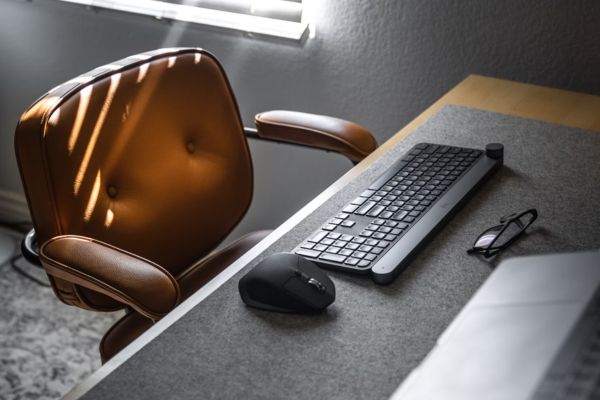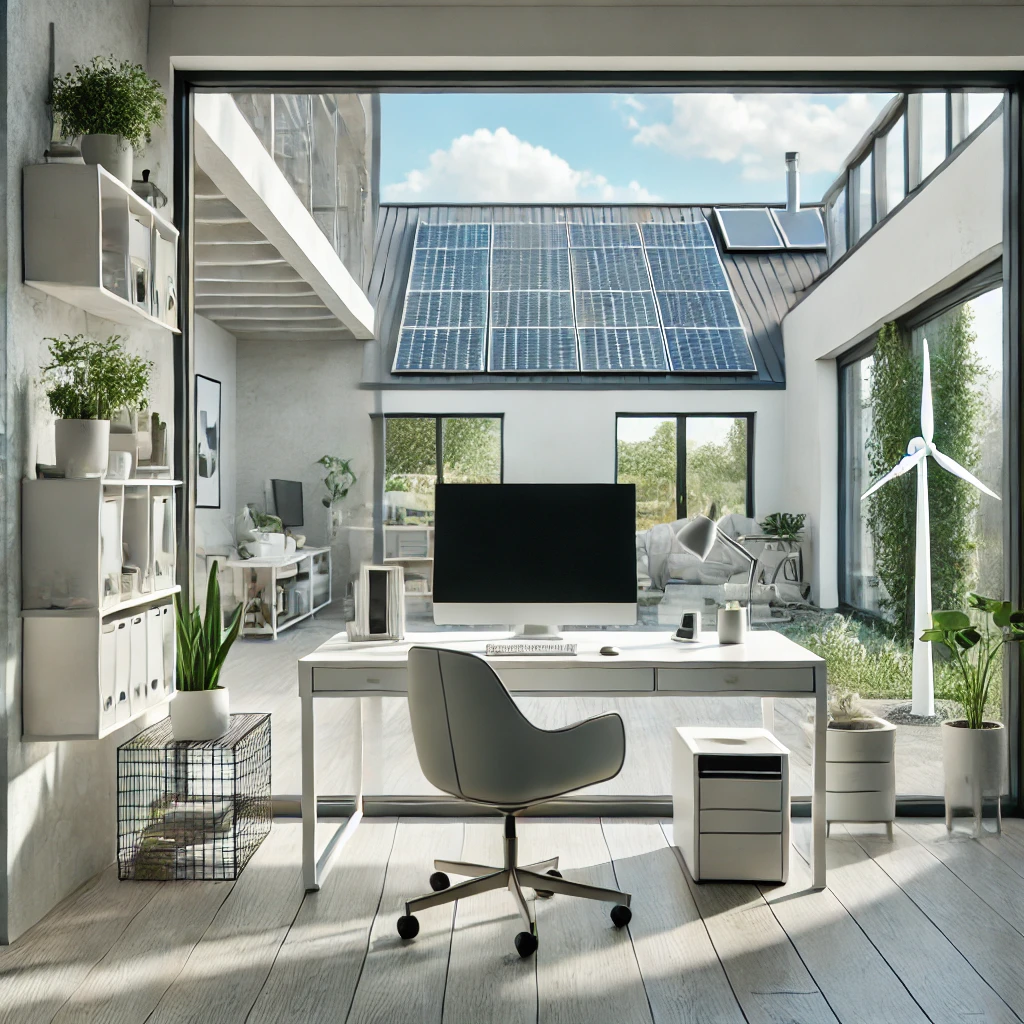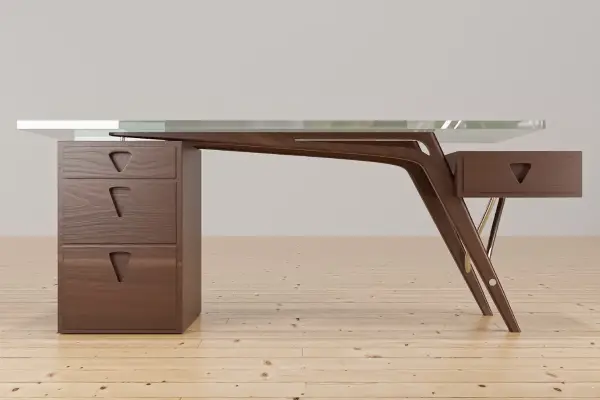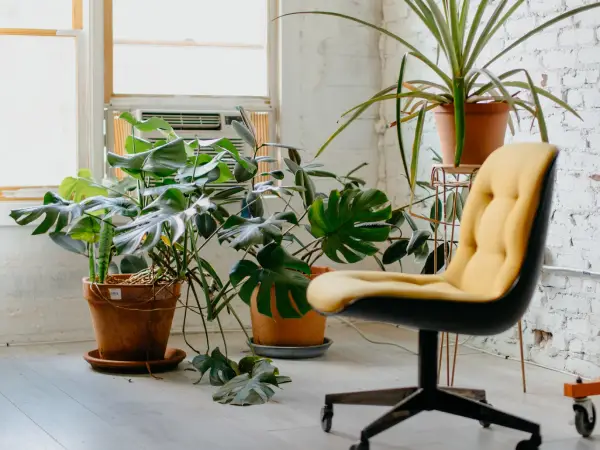Choosing the Right Furniture
Selecting the right furniture is crucial for creating a functional and aesthetically pleasing minimalist office in a small space. Here’s how to make smart choices that enhance your workspace without overcrowding it.
Size Matters
Opt for Appropriately Scaled Furniture
Compact Desks: Choose a desk that fits comfortably within your space. Consider wall-mounted desks or floating desks that take up less floor space.
Slim Storage Solutions: Opt for narrow shelves and cabinets that provide ample storage without taking up too much room.
Petite Seating: Select chairs that are appropriately sized for your space. Armless chairs or chairs with a smaller footprint can help keep the area open and uncluttered.
Multi-Functional Furniture
Benefits of Using Multi-Purpose Pieces
Desk with Built-in Storage: A desk with drawers or shelves can eliminate the need for additional storage furniture, keeping your workspace streamlined.
Convertible Furniture: Consider furniture that can serve multiple purposes, such as a fold-out desk that doubles as a dining table or a sofa bed that can be used for guests.
Storage Ottomans and Benches: These pieces can provide seating as well as hidden storage, perfect for keeping clutter out of sight.
Minimalist Design
Selecting Furniture with Clean Lines and Simple Designs
Avoid Ornate Details: Choose furniture with straight lines and minimal decorative elements to maintain a clean and modern look.
Neutral Colors: Opt for furniture in neutral tones like white, black, or natural wood to create a cohesive and calming environment.
Open and Airy Pieces: Furniture with open designs, such as desks with slender legs or shelves without backs, can make the space feel larger and less cluttered.
Practical Considerations
Ensuring Functionality Without Sacrificing Style
Ergonomic Furniture: Prioritize ergonomic chairs and desks that support your health and comfort, even in a minimalist design.
Durability: Choose high-quality furniture that will withstand daily use and maintain its appearance over time.
Ease of Assembly and Movement: Opt for lightweight, easy-to-assemble furniture that can be moved or reconfigured as needed.
By choosing furniture that is appropriately sized, multi-functional, and minimalist in design, you can create a small office that is both stylish and highly functional. Thoughtful furniture selection ensures that your workspace remains uncluttered, comfortable, and conducive to productivity, all while adhering to the principles of minimalism.
Optimizing Desk Placement
The placement of your desk is a key factor in maximizing the functionality and comfort of your small minimalist office. Here are some tips to ensure your desk is positioned optimally for productivity and aesthetic appeal.
Natural Light
Positioning Your Desk Near Windows
Maximize Daylight: Place your desk near a window to take advantage of natural light, which can improve mood, energy levels, and productivity. Ensure that the light source is neither directly behind nor in front of your screen to avoid glare.
Enhance View: A desk positioned by a window can offer a pleasant view, providing a mental break and reducing eye strain. However, make sure the view doesn’t become a distraction.
Ergonomics
Ensuring the Desk and Chair Setup Promotes Good Posture and Comfort
Correct Height: Your desk should be at a height where your forearms rest parallel to the floor when typing. Pair it with an adjustable chair to achieve the best ergonomic position.
Monitor Position: The top of your computer monitor should be at or just below eye level, about an arm’s length away. Consider using a monitor stand or adjustable arm to achieve this.
Foot Support: Ensure your feet rest flat on the floor or use a footrest to maintain a comfortable sitting posture.
Accessibility
Keeping Frequently Used Items Within Arm’s Reach
Efficient Layout: Arrange your desk so that your most-used items, such as your computer, phone, and notepads, are easily accessible without having to stretch or move excessively.
Storage Solutions: Use desk organizers, trays, and small drawers to keep essential items orderly and within easy reach. This minimizes clutter and maximizes workspace efficiency.
Cable Management: Keep cables tidy and out of the way with clips, ties, or a cable management box. This not only improves the desk’s appearance but also prevents tangling and potential accidents.
Space Utilization
Maximizing Floor Space with Smart Desk Placement
Corner Desks: Utilize corners to free up central floor space. L-shaped desks can provide ample work surface while fitting neatly into a corner.
Floating Desks: Wall-mounted desks save floor space and create a minimalist look. They are particularly useful in very small offices where every inch counts.
Foldable Desks: Consider foldable or drop-leaf desks that can be tucked away when not in use, offering flexibility in space utilization.
Personalization
Adding Personal Touches Without Cluttering
Minimalist Decor: Include a few personal items, such as a small plant, a photo frame, or a piece of art, to make the space feel welcoming without overwhelming it.
Functional Accessories: Use aesthetically pleasing and functional desk accessories, such as a sleek desk lamp, a stylish clock, or a minimalist desk organizer.
By strategically placing your desk to take advantage of natural light, ensuring ergonomic comfort, and keeping essential items accessible, you can create a workspace that boosts productivity and maintains a minimalist aesthetic. Thoughtful desk placement is a cornerstone of an efficient, comfortable, and visually pleasing small office.
Efficient Storage Solutions
In a small minimalist office, efficient storage solutions are essential for maintaining a clutter-free and organized workspace. Here are some strategies to optimize storage while preserving the clean, open feel of minimalism.
Vertical Storage
Utilizing Shelves and Wall-Mounted Units
Maximize Wall Space: Install shelves or wall-mounted cabinets to use vertical space effectively. This keeps items off the floor and desk, freeing up valuable workspace.
Floating Shelves: Floating shelves are sleek and unobtrusive, offering storage without bulky supports. Use them to display essential items or minimalist decor.
Pegboards and Hooks: Pegboards with hooks can be customized to hold office supplies, tools, and decorative items. They are versatile and can be rearranged as needed.
Hidden Storage
Incorporating Storage Solutions That Keep Clutter Out of Sight
Under-Desk Drawers: Attach drawers or storage units under your desk to store supplies and documents. These keep essential items accessible yet hidden from view.
Storage Bins and Baskets: Use minimalist storage bins or baskets to store loose items. Choose ones that fit under your desk or on shelves to keep the office tidy.
Closed Cabinets: Opt for cabinets with doors to conceal items that can make the space look cluttered, such as files, books, and electronics.
Decluttering Tips
Regularly Purging Unnecessary Items to Maintain a Minimalist Environment
Weekly Clean-Up: Set aside time each week to tidy your desk and office area. Remove items that you no longer need and organize the rest.
Paper Management: Digitize documents whenever possible to reduce paper clutter. Use a filing system for necessary paper documents and recycle or shred the rest.
Essential Items Only: Keep only what you use regularly on your desk and in accessible storage. Store infrequently used items in less accessible places or get rid of them.
Multi-Functional Furniture
Choosing Furniture That Offers Additional Storage
Storage Desks: Desks with built-in drawers or shelves provide extra storage without needing additional furniture.
Ottomans and Benches with Storage: These can serve as seating and storage, perfect for keeping extra supplies, books, or personal items out of sight.
Convertible Furniture: Consider furniture pieces that can change functions, such as a bookshelf that doubles as a room divider.
Aesthetic Considerations
Keeping Storage Solutions Aligned with Minimalist Design Principles
Simple Designs: Choose storage units with clean lines and neutral colors to maintain a cohesive and uncluttered look.
Consistent Materials: Use storage solutions made from materials that match or complement the rest of your office furniture, such as wood, metal, or sleek plastics.
Minimalist Decor: Keep decorations simple and sparse on storage units. A few well-placed items can add personality without overwhelming the space.
By incorporating vertical and hidden storage solutions, regularly decluttering, and choosing multi-functional and aesthetically pleasing furniture, you can maintain an organized, efficient, and visually appealing minimalist office. Efficient storage is key to making the most of a small space while preserving the principles of minimalism.
Creating Zones
Dividing your small office into distinct zones can enhance organization, improve productivity, and make the space feel more spacious and purposeful. Here’s how to effectively create zones in a minimalist office.
Work Zone
Designating a Primary Area for Focused Tasks
Central Desk Placement: Position your desk as the focal point of the work zone. Ensure it’s free from distractions and has all necessary tools within reach.
Clear Boundaries: Use rugs, different flooring, or even a slight change in wall color to demarcate the work zone from other areas. This creates a visual boundary that helps in maintaining focus.
Minimal Distractions: Keep this area clutter-free and limit personal items to a few essentials to maintain a clean and efficient workspace.
Relaxation Zone
Setting Up a Small Area for Breaks
Comfortable Seating: Include a small chair or a cozy corner with a floor cushion where you can relax and take short breaks.
Calm Atmosphere: Use calming colors and minimal decor to create a peaceful space. A small plant or a piece of art can add a touch of serenity.
Functional Use: Ensure that this zone is separated from the work area to provide a mental and physical break from your desk.
Meeting Zone
Incorporating a Space for Virtual or In-Person Meetings
Compact Setup: If space allows, include a small table and a couple of chairs for in-person meetings. Alternatively, designate a part of your desk for virtual meetings with a clean backdrop.
Privacy Considerations: Use a room divider, curtains, or a movable screen to create a sense of privacy if your meetings require it.
Tech-Friendly: Ensure that the meeting zone has good lighting, a stable internet connection, and access to necessary devices like a webcam and microphone.
Storage Zone
Dedicated Area for Storage Solutions
Vertical Organization: Use tall shelves and cabinets to store items vertically, saving floor space. Arrange items by frequency of use, with everyday items within easy reach.
Concealed Storage: Opt for closed storage solutions like cabinets with doors to keep clutter hidden and maintain a clean look.
Labeling and Categorizing: Label storage boxes and bins to easily find items and keep the storage zone organized.
Flexibility in Zoning
Maintaining an Adaptable Layout
Modular Furniture: Use modular furniture that can be easily reconfigured as your needs change. This allows for flexibility in creating and adjusting zones.
Open Space: Leave some open space to provide flexibility for future adjustments. This also helps the office feel less cramped and more open.
Regular Reassessment: Periodically review your office layout and zones to ensure they still meet your needs and make adjustments as necessary.
By creating distinct zones for work, relaxation, meetings, and storage, you can optimize the functionality and flow of your small minimalist office. Each zone serves a specific purpose, helping to maintain organization and enhancing productivity while adhering to minimalist design principles.
Enhancing the Aesthetic
A minimalist office is not just about functionality but also about creating a visually pleasing and serene environment. Here’s how to enhance the aesthetic of your small office while maintaining a minimalist approach.
Color Scheme
Using a Neutral Palette to Create a Calm and Cohesive Look
Light Colors: Opt for light and neutral colors like white, beige, light grey, and soft pastels. These colors reflect light and make the space feel larger and more open.
Accent Colors: Introduce subtle accent colors through accessories or a single wall to add interest without overwhelming the space. Stick to a consistent color scheme to maintain cohesion.
Consistency: Ensure that furniture, walls, and decor follow the same color palette to create a unified look.
Minimalist Decor
Adding a Few Well-Chosen Decorative Items to Personalize the Space Without Overwhelming It
Functional Decor: Choose decor items that also serve a purpose, such as a stylish clock, a minimalistic lamp, or a beautiful but functional storage basket.
Artwork and Prints: Select a few pieces of art or prints that inspire you. Opt for simple frames and avoid overcrowding the walls.
Plants: Incorporate small plants or succulents to bring a touch of nature indoors. Plants can improve air quality and add a pop of color.
Greenery
Introducing Plants to Add a Touch of Nature and Improve Air Quality
Low-Maintenance Plants: Choose plants that are easy to care for, such as succulents, snake plants, or pothos. These require minimal attention but provide significant aesthetic benefits.
Placement: Place plants on shelves, window sills, or even hanging planters to save desk space. Use plants to fill empty corners and add life to the room.
Planter Style: Use planters that match your minimalist aesthetic. Simple ceramic pots in neutral colors work well.
Texture and Materials
Incorporating Different Textures to Add Depth and Interest
Natural Materials: Use materials like wood, metal, and stone to add natural textures. A wooden desk or metal shelving can enhance the minimalist look.
Soft Textures: Add softness with a textured rug, a cozy throw blanket, or a fabric chair. These elements can make the space feel more inviting.
Balanced Mix: Ensure a balance of textures to avoid a flat, monotonous look. Mix smooth, rough, soft, and hard surfaces for a visually engaging space.
Lighting
Choosing the Right Lighting to Enhance the Ambiance
Natural Light: Maximize natural light by keeping windows unobstructed. Use sheer curtains if privacy is needed.
Task Lighting: Add task lighting, such as a desk lamp, to provide focused light where needed. Choose a sleek, minimal design that complements the overall aesthetic.
Ambient Lighting: Use soft ambient lighting to create a warm and inviting atmosphere. Consider floor lamps or wall sconces with simple designs.
Personal Touches
Adding Personal Items Thoughtfully
Selective Personalization: Include a few personal items that inspire you, such as a favorite book, a small sculpture, or a photo. Keep these to a minimum to maintain the minimalist feel.
Organized Display: Display personal items in an organized manner. Use trays, stands, or shelves to keep things tidy and visually appealing.
Functional Personal Items: Opt for personal items that also serve a practical purpose, such as a stylish pen holder or an elegant notebook.
By focusing on a cohesive color scheme, incorporating functional and minimalist decor, adding greenery, and carefully selecting textures and lighting, you can enhance the aesthetic of your small office. These elements work together to create a minimalist space that is not only functional but also visually pleasing and serene.
Conclusion
Creating a small minimalist office that is both functional and stylish requires thoughtful planning and a keen eye for design. By assessing your space, choosing the right furniture, optimizing desk placement, and incorporating efficient storage solutions, you can make the most of your limited space. Dividing your office into distinct zones and enhancing the aesthetic with a cohesive color scheme, minimal decor, and thoughtful lighting can transform your workspace into an efficient and visually pleasing environment.
Recap of Key Points:
Assess Your Space: Accurate measurements and purposeful planning lay the groundwork for a functional layout.
Choose the Right Furniture: Select appropriately sized, multi-functional, and minimalist pieces to maximize space and maintain a clean look.
Optimize Desk Placement: Position your desk to benefit from natural light, ensure ergonomic comfort, and keep essential items accessible.
Efficient Storage Solutions: Use vertical and hidden storage, declutter regularly, and incorporate multi-functional furniture to keep your space organized.
Create Zones: Designate areas for work, relaxation, meetings, and storage to enhance functionality and flow.
Enhance the Aesthetic: Maintain a cohesive color scheme, incorporate minimalist decor and greenery, add texture, and ensure proper lighting to create a serene and inviting workspace.
Investing time and effort into designing your small minimalist office can yield significant benefits. A well-organized, clutter-free environment not only boosts productivity but also promotes a sense of calm and well-being. By following the principles outlined in this guide, you can create a workspace that is tailored to your needs and preferences, blending comfort and style seamlessly.
Ready to transform your small office into a minimalist haven? Start by assessing your space and planning your layout today. With the right approach, you can achieve a functional, stylish, and serene workspace that supports your productivity and well-being. Explore our recommended furniture and decor options to find pieces that perfectly match your minimalist vision. Happy designing!






